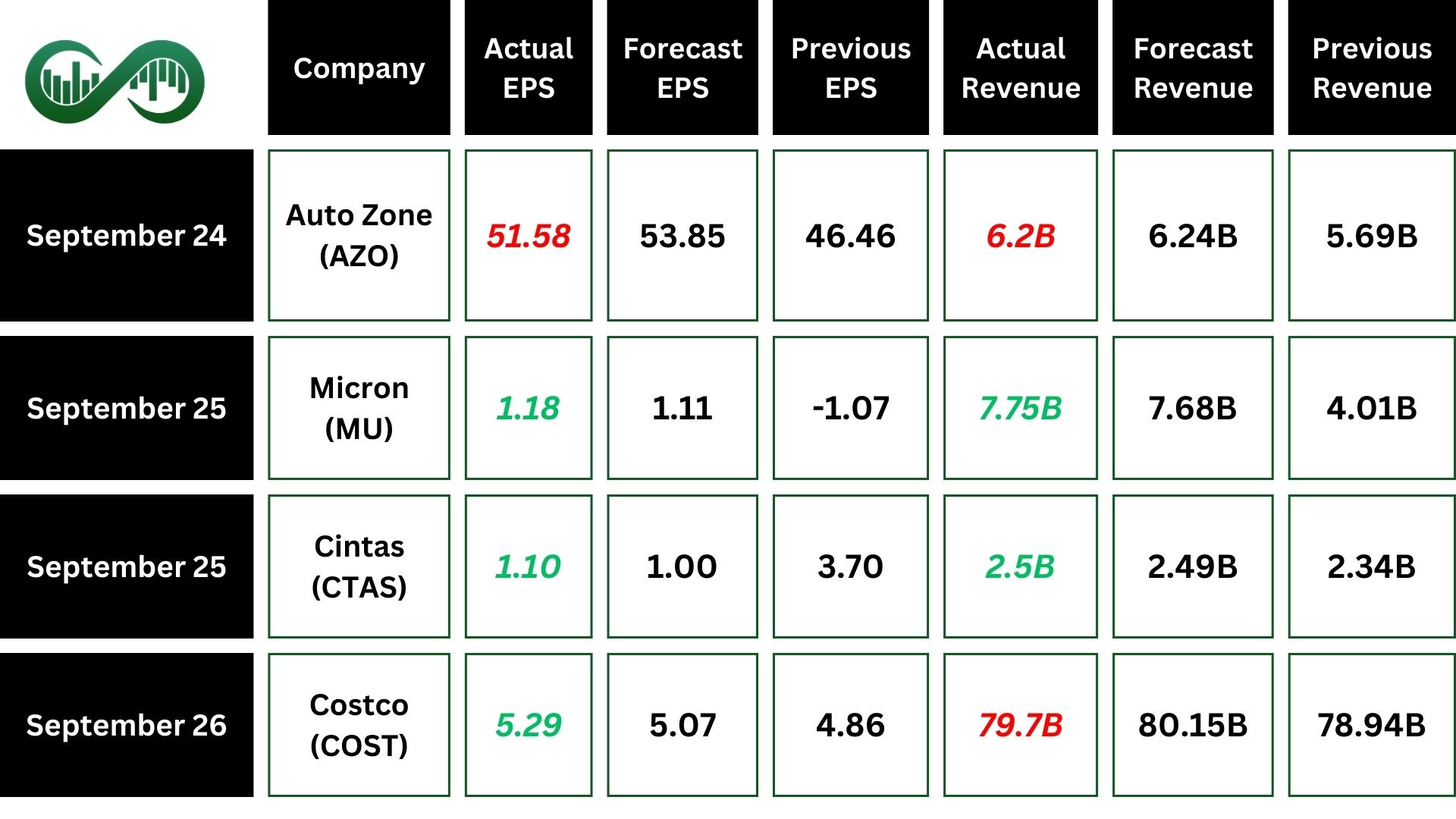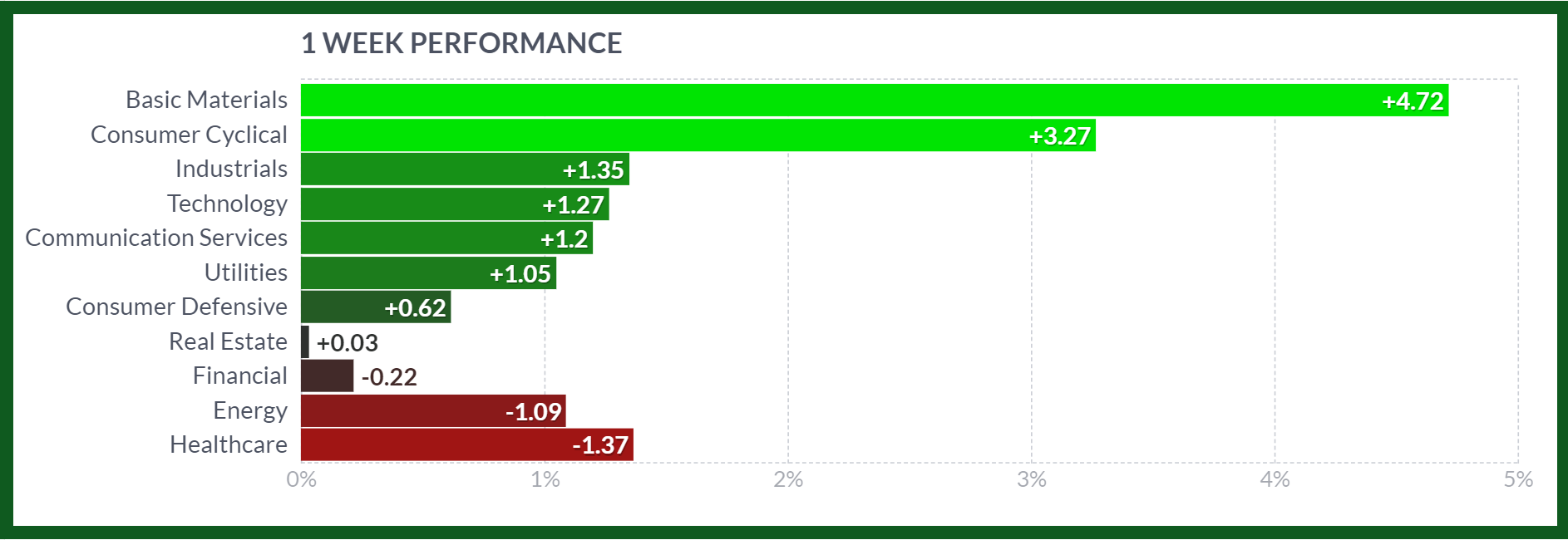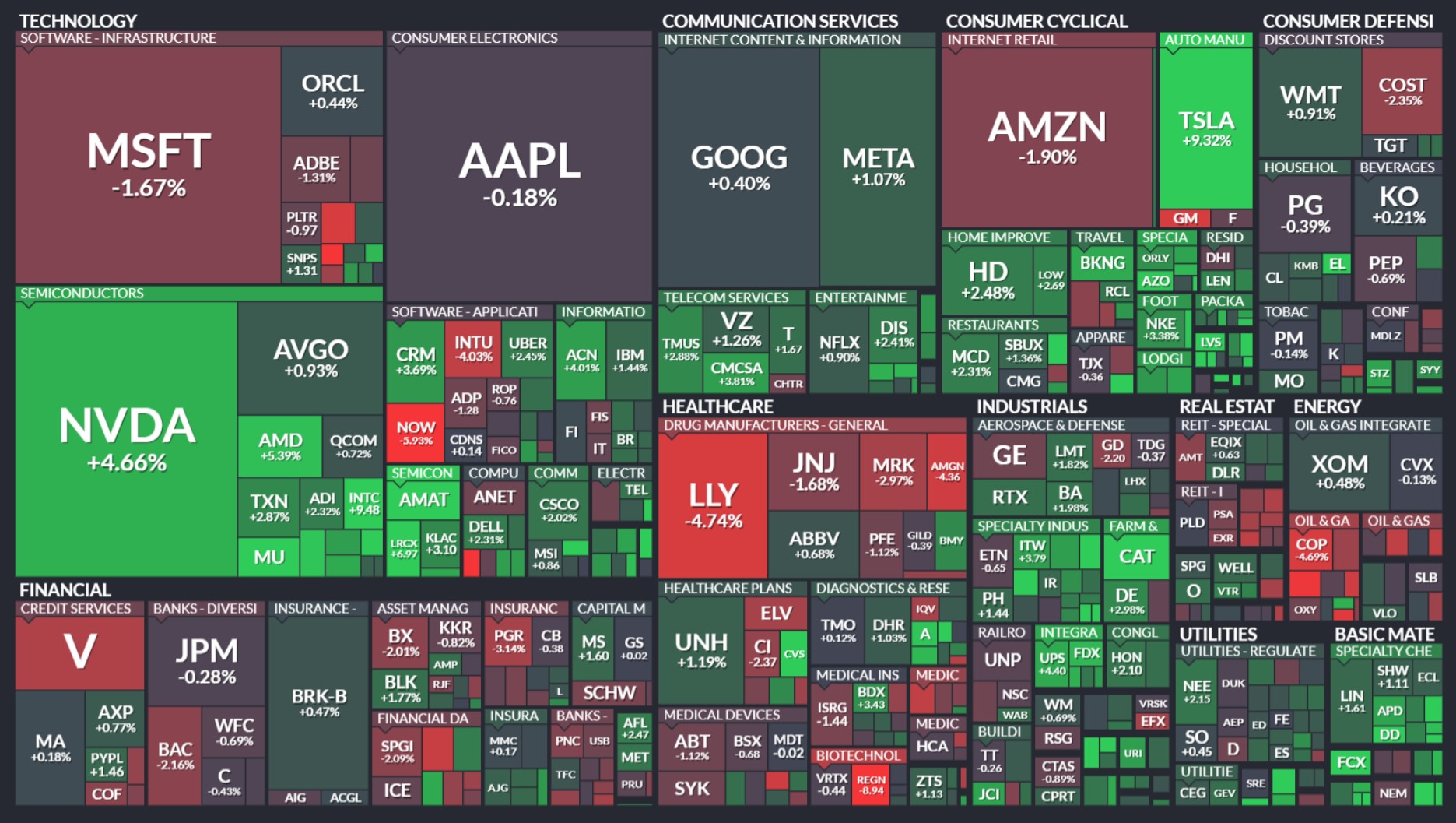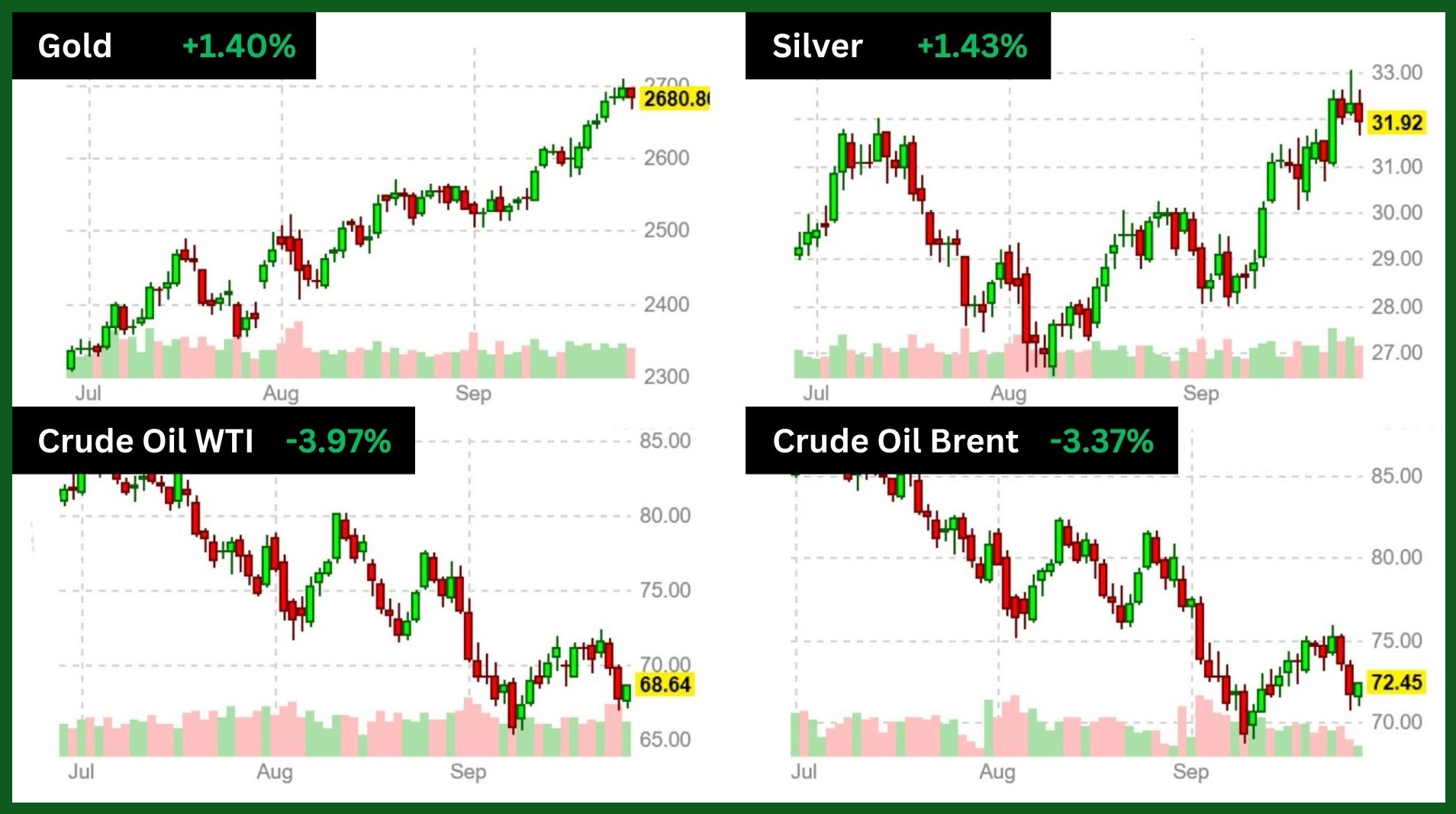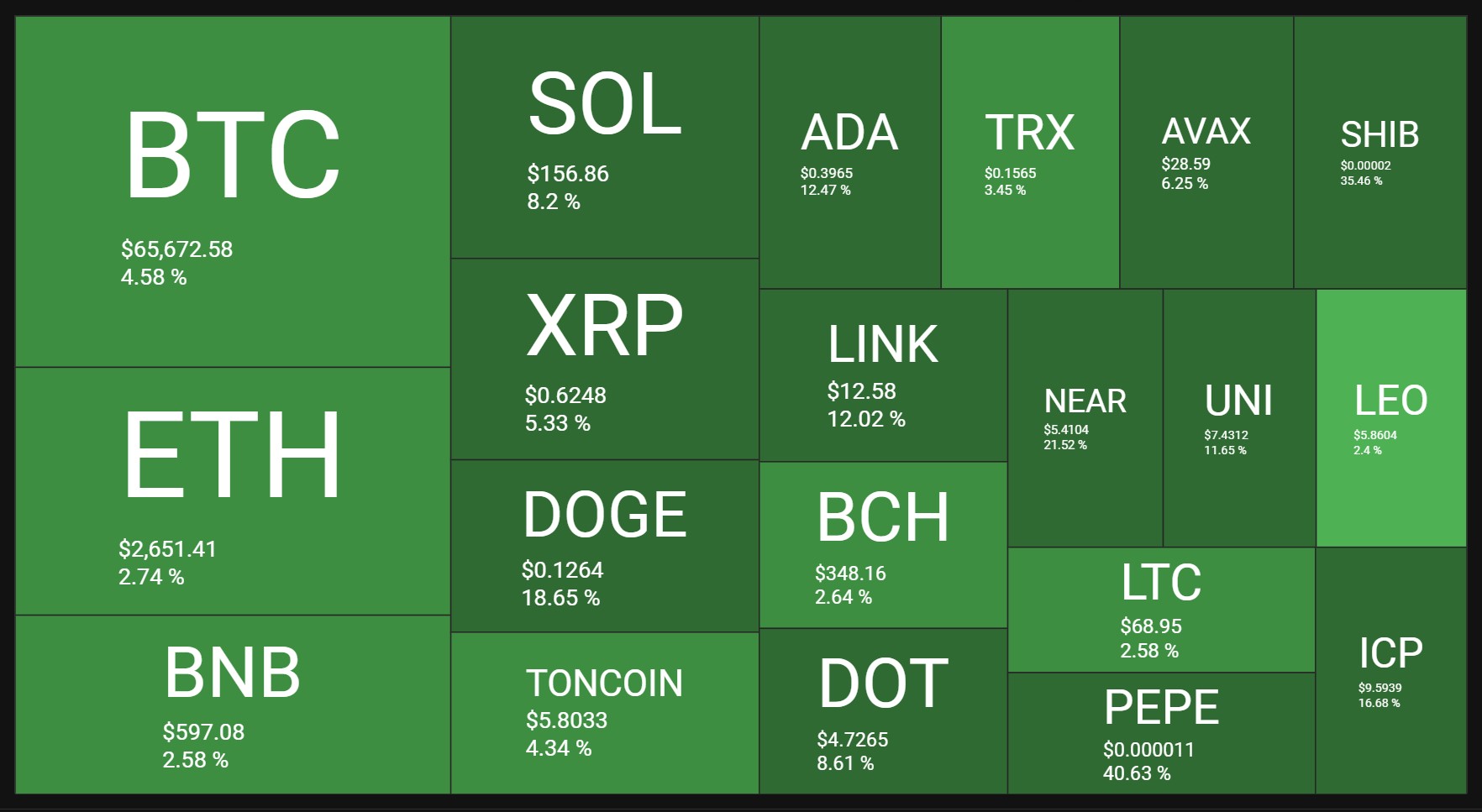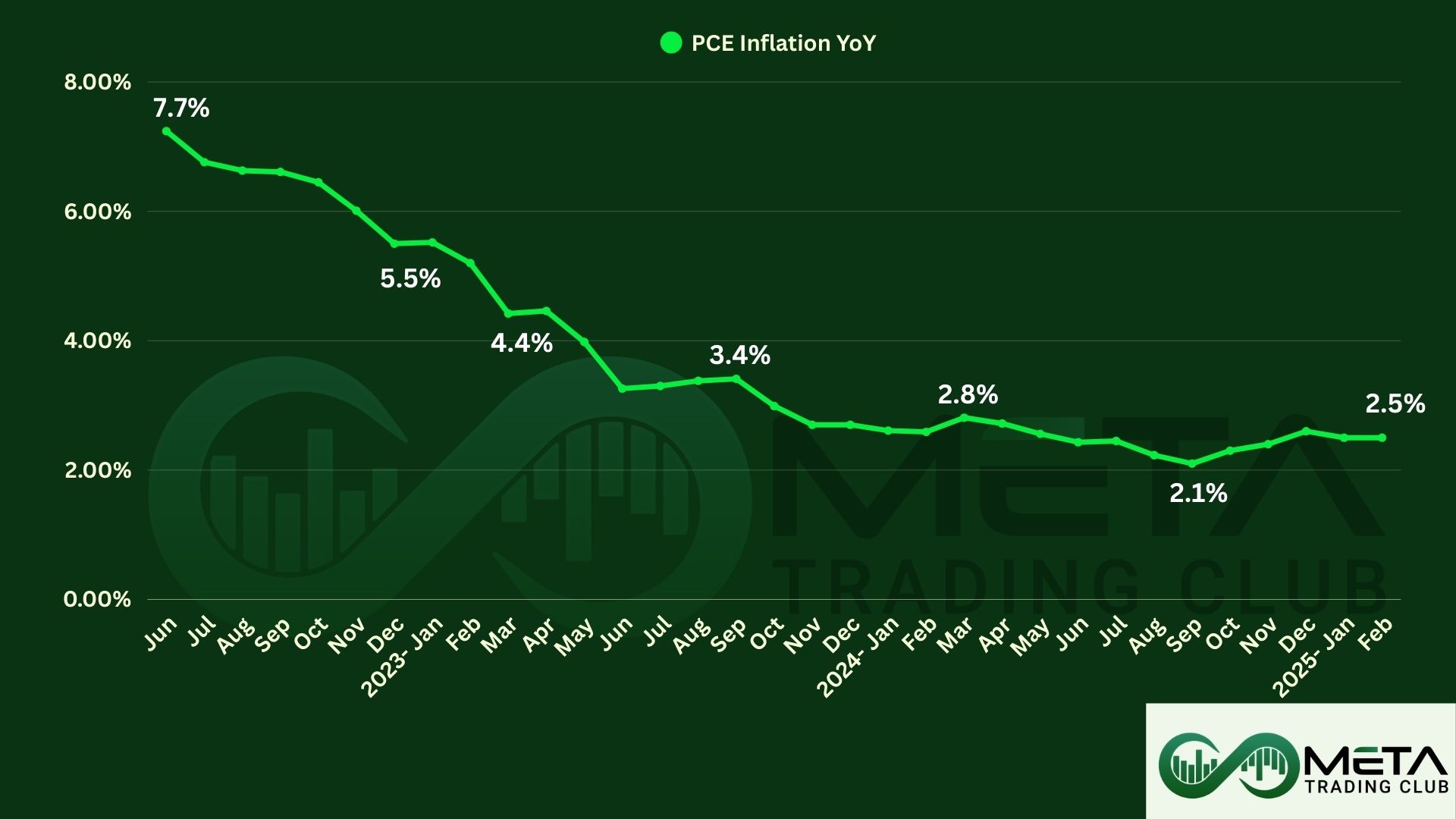Last week’s market and economic data key points:
- PCE inflation dropped to 2.2%, below forecast
- China central bank cut policy rates
- Chinese stocks surged; Alibaba gained 20% in a week
- S&P 500 and DJI slides after hit records
- Micron rose 18% in earning week
- Nvidia CEO dumped $713M NVDA shares
- Intel shares gained after Apollo’s $5B offer
- SMCI crashes due to DOJ probe
- Tesla gained 9% last week
- Gold set a new record; Silver reached 12-year high
- Bitcoin reached two months high of $66,000
- Shiba surged 35% and Doge gained 20% last week
Table of Contents
Last Week’s Reports
Economic Reports
In August, U.S. durable goods orders remained flat, with no significant monthly change following a strong 9.9% surge in July. However, the result was better than economists’ expectations of a 2.6% drop. Excluding transportation, durable goods orders increased by 0.5%, reflecting resilience in sectors like electrical equipment and appliances.
The U.S. GDP growth rate for Q2 2024 was finalized at 3% QoQ, indicating stronger-than-expected economic performance. The 3% figure reflects robust economic activity. This could be as a sign of economic stability, though concerns remain about the potential for a slowdown in future quarters.
The August PCE Price Index showed a monthly increase of 0.1% and a yearly rise of 2.2%. This data reflects a slowdown in inflation, providing evidence that price pressures are easing. The lower-than-expected inflation rate supports the narrative of a “soft landing” for the U.S. economy, potentially allowing the Federal Reserve to more rate cut confidently.
Also, the U.S. personal income and personal spending both rose by 0.2%, falling short of economists’ expectations. This moderate growth suggests consumer activity is slowing, reflecting cooling economic conditions. The lower-than-expected rise in spending signals that inflation pressures might be easing, contributing to a more cautious outlook on economic momentum.
In September, Michigan Consumer Sentiment further improved, climbing to 70.1, surpassing analysts’ expectations of 69.3. This increase reflects broader optimism, especially regarding business expectations, which rose by 6%. Also, the Index of Michigan Consumer Expectations rose to 74.4. Overall, while consumers remain cautious due to persistent inflation, the sentiment data suggests a growing confidence in the economy, influenced by evolving political dynamics as the upcoming elections shape public expectations.
Earning Reports
AutoZone
AutoZone (AZO) Q4 2024 earnings report highlighted a 9% yearly increase in revenue, totaling $6.2 billion, though this slightly missed analyst estimates. Same-store sales rose by 1.3%, while domestic same-store sales grew by 0.2%.
The company’s earnings per share (EPS) came in at $51.58, below expectations of $53.53.
Despite missing estimates, AutoZone opened 117 new stores during the quarter, including 68 in the U.S., 31 in Mexico, and 18 in Brazil. This brought the total store count to 7,353 globally. The company also repurchased $710.6 million worth of shares, continuing its aggressive buyback program.
The stocks experienced a $300 increase after the earnings report was released.
Costco
Costco (COST) reported solid results for its Q4, 2024. The company’s total revenue reached $79.7 billion, a 1% yearly increase. Also, net sales for the quarter came in at $78.2 billion, up from the previous year.
Membership fees contributed $1.51 billion, reflecting continued growth in Costco’s membership base.
The company’s net income rose to $2.35 billion, or $5.29 per share, compared to Q4 2023. This beat analyst earnings expectations but fell slightly short in revenue estimates.
Costco’s performance was driven by strong sales in groceries and services, as well as stable membership renewals. However, revenues were affected by lower gasoline prices and the strong U.S. dollar, which impacted international sales.
The stock’s price fell 1.75% after the earnings report was released.
Micron
Micron (MU) Technology reported strong fourth-quarter results for fiscal year 2024. This report is driven by surging demand in the AI and data center markets.
The company posted revenue of $7.75 billion, a 93% yearly increase, surpassing analyst expectations. Adjusted earnings per share came in at $1.18, beating the consensus estimate.
In contrast to a loss in the same quarter last year, Micron’s net income was $887 million.
Micron’s growth was fueled by significant demand for its DRAM and NAND memory products, particularly in data centers. AI applications played a key role in boosting demand, contributing to a record-breaking quarter for NAND-based data center SSDs, which exceeded $1 billion in revenue for the first time.
Looking ahead, Micron provided optimistic guidance, forecasting first-quarter 2025 revenue of $8.7 billion, with adjusted earnings of $1.74 per share, signaling strong momentum into the next fiscal year.
This upbeat outlook, along with better-than-expected Q4 performance, pushed Micron’s stock price up by more than 18% last week.
China Stimulus Package
China’s recent economic stimulus package, unveiled on September 24, is aimed at reviving its sluggish economy and achieving a growth target of 5% for the year. This stimulus is the most substantial since the pandemic and includes measures such as cutting interest rates and lowering bank reserve requirements, which are intended to boost lending by freeing up approximately 1 trillion yuan (around $142 billion).
The immediate reaction in the stock market has been overwhelmingly positive. The CSI 300 index, which tracks major companies listed in Shanghai and Shenzhen, surged by 15%, marking its best performance in over two years. Similarly, Hong Kong’s Hang Seng index saw a rise of about 13%.
Additionally, major companies with exposure to China, like Alibaba and JD.com, experienced significant stock gains, highlighting the optimism among investors.
However, despite this initial surge, economists express caution regarding the long-term effectiveness of these measures. Concerns persist about weak loan demand and the overall economic environment, especially given the ongoing challenges in China’s property sector. Some analysts argue that further fiscal stimulus may be necessary to achieve a more sustained recovery.
After the announcement, U.S. markets saw positive reactions, with the S&P 500 and Dow Jones Industrial Average hitting record highs. Stocks with direct exposure to China, as well as those in commodities, technology, and consumer goods, have benefited.
While these immediate effects are encouraging, analysts caution that the long-term effectiveness of the stimulus is still uncertain. Concerns remain that additional fiscal measures may be necessary to fully revive domestic demand in China.
Overall, the situation underscores the interconnectedness of global economies, where China’s economic health can significantly influence U.S. market performance.
Indices
Indices’ Weekly Performance:
For the week ending September 27, U.S. major stock indices experienced mixed performance. The Dow Jones Industrial Average rose by 0.59%, while the S&P 500 slipped slightly by 0.62%, finishing at 5,738. The Nasdaq gained 1.1%, thanks to semiconductors. Market optimism was buoyed by easing Treasury yields and reports indicating that inflation and consumer spending growth slowed, alleviating concerns about a potential recession.
The S&P 500 continued its upward trajectory primarily due to favorable economic indicators, including a cooling inflation rate. Also, the index attributed to positive sentiment surrounding economic data and potential stimulus measures from China.
Stocks
Stock Market Sector’s Weekly Performance:
Source: Finviz
Basic materials was the strongest-performing sector during the week with 4.7% gain. This performance was followed by consumer cyclicals with 3.2% surge. While the energy and healthcare sectors dropped more than 1%.
Stock Market Weekly Performance:
Source: Finviz
Overall, the week showed an upward trend in the stock market, as concerns about inflation easing and a potential economic soft landing continued to support investor sentiment. The economic indicators suggest moderating inflation and a stable consumer spending environment.
Semiconductors
Advanced micro devices(AMD) announced that Oracle Cloud Infrastructure (OCI) has chosen AMD MI300X accelerators to power its newest OCI Compute Supercluster instance called BM. AMD Instinct MI300X and ROCm open software continue to gain momentum as trusted solutions for powering the most critical OCI AI workloads.
AMD broke and pulled back to the down trend line. If it isn’t a failure breakout, the price would rise till the next resistance level.
Nvidia (NVDA) CEO Jensen Huang just wrapped up the sale of six million shares of the chip maker, completing a trading plan he adopted earlier in the year.
Huang’s plan sold shares from a personal account that now owns 75.4 million Nvidia shares. He also owns 786 million company shares through trusts and partnerships.
Huang is the largest individual owner of Nvidia stock, owning a 3.8% stake as of the end of March, before his 2024 stock sales. He could adopt another plan to sell even more shares, but his 2024 transactions already dwarf what he sold last year.
NVDA has been consolidating through last couple months. For pump or dumping in price, firstly the stocks need to break above or below this zone.
Super Micro Computer (SMCI) shares are falling last week following a report indicating the company is being probed by the Department of Justice following an August short report from Hindenburg Research. The DOJ probe is in the early stages. SMCI has declined 70% from its top.
Intel (INTC) stock surged following reports that Apollo Global Management has taken a stake in the company.
Apollo Global Management is considering a significant investment of up to $5 billion in Intel. This move is seen as a vote of confidence in Intel’s potential for recovery and growth.
This investment comes at a time when Intel has been struggling with stock declines and increased competition in the semiconductor industry. This news, although not officially confirmed, suggests a positive outlook for Intel.
Tesla
Tesla (TSLA) shares added 9.3%, their third consecutive week of gains. The shares added 3.5% this past week and 9.3% the week before that.
This week’s news of economic stimulus in China is a clear positive for the stock. Because a healthier economy can ease stress on consumers, helping to boost demand for cars.
Roughly one-quarter of all Chinese new car sales are all-electric. Tesla generates roughly one-third of its sales in China. In recent months, its Model Y was the best-selling EV in China.
After these 3-weeks surge in price, Tesla shares reached to a cluster resistance zone. This cluster is a Fibonacci projection area and simultaneously a 2-year downtrend line.
Alibaba
Chinese e-commerce titans Alibaba (BABA) and JD.com (JD) have decided to integrate their ecosystems to combat slowing user growth and increased regulatory scrutiny.
The collaboration between Alibaba and JD.com is significant in the context of their recent competitive maneuvers and regulatory challenges.
Additionally, both Alibaba and JD.com have seen positive market reactions following economic stimulus measures announced by China’s central bank.
As a result, Alibaba’s shares rose by 20%, while JD.com’s shares increased by 37%.
Commodity
Weekly Performance of Gold, Silver, WTI and Brent Oil:
Source: Finviz
Gold hit the record high of $2,685 amid increasing confidence that the Federal Reserve will go forward with a series of rate cuts in their upcoming decisions.
Also, PCE price index refrained from rising in August, while personal income and spending both slowed more than expected in the period.
The data aligned with a backdrop that allows the Fed to continue lowering its funds rate to attend to a softening labor market.
Consequently, markets raised bets that the central bank could deliver back-to-back 50 bps rate cuts in its upcoming November meeting.
Silver extended its strong momentum to reach $32.5 per ounce last week, its highest record in 12 years. The silver tracked the strong momentum of gold due to bets of incoming rate cuts by the Federal Reserve.
In the meantime, silver also received support from the fresh announcements of aggressive fiscal and monetary stimulus measures to support the world’s second-largest economy.
Oil prices fell about 4% last week as investors focused on expectations of higher supplies from Libya and the broader OPEC+ group of oil exporters.
Forex
Weekly Performance of Major Foreign Exchange Pairs:
- DXY: The dollar traded mixed as Treasury yields eased following data that showed U.S. inflation pressures easing and growth moderating.
- EUR/USD: The euro traded defensively amid growing risks of an European Central Bank rate cut in October with market pricing at 80%.
- USD/JPY: Japan’s incoming prime minister, Shigeru Ishiba, said the BOJ should decide monetary policy.
- GBP/USD: UK retail sales grew at the fastest pace since May, according to the CBI industry report.
- USD/CAD: Canada’s gross domestic product expanded at a faster-than-expected 0.2% rate in July, but an advance estimate indicated that growth likely stalled in August.
- AUD/USD: The Australian dollar briefly touched a new 2024 high following the U.S. data.
Crypto
Crypto Market Weekly Performance:
Source: quantifycrypto
Dogecoin has seen a sharp increase in activity. In just one day, 9.4 billion DOGE were moved, setting a new record for whale activity in the last 30 days.
The current whale movement suggests that large holders are becoming more interested, which could lead to further price increases.
DOGE’s price recently broke through significant resistance levels and began to exhibit indications of a possible bullish reversal.
Shiba price continues to hit a higher value and has increased by 35% in the last seven days.
Interestingly, this surge coincided with a massive rise in Shiba Inu whale transactions. This rise also appears to be pivotal in the recent upswing.
Next Week’s Outlook
Economic Events
In this week’s economic data, the jobs report expected to show nonfarm payrolls increased by 145K in September.
The unemployment rate is forecasted to remain at 4.2% and wage growth may have slowed to 0.3%.
Along with the jobs report, other key data such as the JOLTS report, ADP employment figures, and Challenger Job Cuts will also be released.
In addition, the ISM Manufacturing PMI is anticipated to reflect a continued contraction in the factory sector, while the ISM Services PMI is expected to show steady growth.
Earning Events
Large cap companies’ Earnings reports coming this week include Nike (NKE), Paychex (PAYX) and Paychex.
Disclaimer: The views and opinions expressed in the blog posts on this website are those of the respective authors and do not necessarily reflect the official policy or position of Meta Trading Club Inc. The content provided in these blog posts is for informational purposes only and should not be considered as financial advice. Readers are encouraged to conduct their own research and consult with a qualified financial advisor before making any investment decisions. Meta Trading Club Inc shall not be held liable for any losses or damages arising from the use of information presented in the blog posts.



